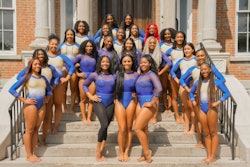Riding the Crest of a Wave
One of Black Issues’ first writers reflects on the growth of a well-timed publication
By Eileen M. O’Brien
It’s always fun to ride the crest of a wave. As one of the first writers at Black Issues In Higher Education, I quickly realized the publication had impeccable timing, covering diversity and minority-serving colleges just as these issues — and new organizations interested in these topics — rose to the forefront of the public-policy arena. And best of all, Black Issues did the investigating to an extent not seen in other press coverage of higher education at the time.
Not that it was easy, of course. As with any new publication, adhering to deadlines was difficult and late hours were common. But as a product of predominantly White schools and colleges, I can genuinely say I learned much about myself, my upbringing and our society in a short amount of time. I rethought many of the pre-conceived notions of my earlier experiences, as I attended sessions examining our judicial system as the lone “White girl” in a room of 200 African American professionals. The knowledge I gained left a lasting impression, one that has led me to work in education — and particularly, on underrepresented populations — for much of the last 15 years.
Looking back, there are many other organizations and leaders who gained prominence at that time. Black Issues’ early years coincided with a period of growth for the Office of Minority Concerns at the American Council on Education, and it might be fair to say that the two “grew up” together. Dr. Reginald Wilson and his successors were very effective in both detailing the progress of African Americans, Latinos, Asian Americans and American Indians in postsecondary education through their annual status reports, and in raising awareness of strategies that enhance and value diversity on campus through their “One Third of a Nation” conferences.
The office, now known as the Center for Advancement of Racial and Ethnic Equity (CAREE), has produced many leaders — Sarah Melendez, former executive director of Independent Sector; Deborah (Carter) Wilds, now with the Bill and Melinda Gates Foundation; Dr. Blandina Cardenas, dean of the College of Education at University of Texas at San Antonio; Hector Garza, president of the National Council for Community and Education Partnerships; and Dr. William Harvey, who is now vice president of ACE and director of CAREE.
Articles on historically Black colleges and universities highlighted another important, but often neglected (in terms of positive press coverage) sector in higher education. Our stories followed the careers of Dr. Johnnetta Cole, Spelman College’s first African American woman president, who is now president of Bennett College; Dr. Frederick Humphries, first as president of Florida A&M University, then as president of the National Association for Equal Opportunity in Higher Education; and Dr. Leroy Keith, who transitioned into the Morehouse College presidency and back out to head Carson Products.
Yet Black Issues didn’t just raise the bar on coverage of these important institutions. The publication also dramatically expanded coverage of two other segments of higher education — the then little-known group of institutions called tribal colleges and the emerging collection of colleges and universities designated as “Hispanic-serving institutions.” In doing research for my articles on tribal colleges, I can safely say that little had been written on these important and growing institutions. Black Issues continued to report on the unique challenges faced by these mostly two-year colleges, including underfunding; physical and cultural isolation on reservations; and struggles to balance more bureaucratic notions of quality (those of accreditation agencies) and their own academic perspectives of preserving native cultures. Similarly, Black Issues documented the emergence of the Hispanic-serving institutions even before the advent of federal legislation to help these institutions.
One of the most significant contributions of Black Issues in those days was our focus on the student in “student-athlete.” In the late 1980s, Black Issues centered attention on student-athletes through coverage of legislation that became known as the Student Right to Know Act and examined in detail the adverse impact of the National Collegiate Athletic Association’s Proposition 48 on Black athletes. A key newsmaker at that time was Dr. Richard Lapchick, then-director of the Center for the Study of Sport in Society at Northeastern University. His research highlighted NCAA data that showed Black athletes were half as likely as their White counterparts to earn a college degree. Black Issues prided itself on extensive coverage of such issues.
Although much of the writing focused on issues of importance to educators of color, Black Issues always maintained an ever-watchful eye on national education policy affecting all Americans. For example, the June 15, 1988, issue focused attention on the policy differences among the three presidential candidates at the time (Vice President George Bush, Massachusetts Gov. Michael Dukakis and the Rev. Jesse Jackson). Working with Chris Edley Jr., Black Issues was able to secure an exclusive interview with Gov. Dukakis on education issues. Such “scoops” did not come easily; I recall having to fly coast to coast just to board the Dukakis plane so I could interview him as he traveled. Over the years, the publication always has featured in-depth interviews with newsmakers on a wide range of topics; noteworthy interviews include those of Texas legislator Wilhelmina Delco, ACE President Frank Rhodes, Education Secretary Lauro Cavazos, demographer Harold “Bud” Hodgkinson and even Gen. Colin Powell.
Black Issues’ coverage of academics, politicians and policy-makers in the early years also seemed prescient. Many of these individuals went on to play major roles in shaping higher education and national policies. In July 1988, for example, articles focused on then-Sen. Al Gore and Gov. Bill Clinton — four years before their nomination and victory.
Articles on research, conference presentations and professional announcements also made it easy for readers to keep up with the movers, shakers and rising stars in the academic world. Examples include Dr. Elaine Copeland, whose early research on Black doctoral candidates with Dr. William Trent shed light on lower completion rates for Black Ph.D.s. Copeland is now president of Clinton Junior College in Rock Hill, S.C. Edley, another early newsmaker, made his first appearance in the publication during his time with the Dukakis campaign. He later became senior adviser to President Clinton’s Race Initiative and now serves as a member of the U.S. Civil Rights Commission. Edley recently was named dean of UC-Berkeley’s Boalt Hall School of Law. The publication also kept up with Jacqueline Woods as she transitioned from an executive at the American Association of Community and Junior Colleges to a Department of Education official in the Clinton administration to the executive director of the American Association of University Women.
Since leaving Black Issues, I have worked for the U.S. Commission on Civil Rights, ACE’s policy analysis and research office, the association representing tribal colleges and the U.S. Education Department. So it’s safe to say that the place had a major impact on my professional career. Looking back, I think it also has left an indelible impression on its readers as well.
— Eileen M. O’Brien is an independent education researcher and consultant in Alexandria, Va. She was senior writer at Black Issues In Higher Education and managing editor of Community College Week from 1987 to 1990.
© Copyright 2005 by DiverseEducation.com



















